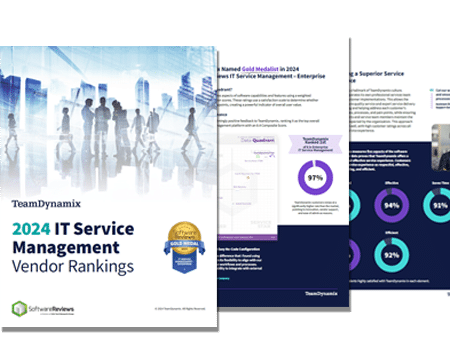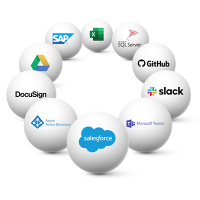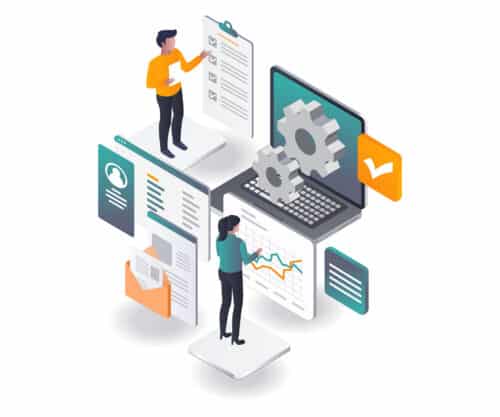
Enterprise Service Management: Why a Unified Platform Matters
Enterprise Service Management (ESM) is the practice of extending IT Service Management (ITSM) principles beyond the IT department to other areas of an organization. ESM

The Info-Tech ranking report offers a unique view of the market based entirely on in-depth customer interviews. Download the Info-Tech ITSM Quadrant and Customer Viewpoint report today.

We’ll show you some of our best situations and show you exactly how to execute them to get immediate results. The best part is, iPaaS tools often feature easy-to-use click and drag functionality, meaning you don’t need a dedicated employee building integrations and workflows.

System Integrators, Value Added Resellers, Technology Providers, and Buying Consortiums can benefit from a partnership with TeamDynamix.

The Info-Tech ranking report offers a unique view of the market based entirely on in-depth customer interviews. Download the Info-Tech ITSM Quadrant and Customer Viewpoint report to gain a better understanding of key vendor strengths and emerging market requirements.
If your organization wants a better understanding of how it currently provides IT support, it is crucial to understand the difference between ITSM vs ITIL (Information Technology Management System vs Information Technology Infrastructure Library). In short, ITSM describes the entire set of processes an organization uses to manage its IT services for customers, whereas ITIL is one specific ITSM framework.
ITSM stands for IT Service Management and refers to the process of managing IT operational services. ITSM describes how an organization facilitates IT service delivery, including the management of all resources and employees involved in providing it – such as IT administrators, service providers, vendors, and customers. ITSM covers several key tactical IT concepts, including but not limited to the operation of an IT service desk (including helpdesk functionality).
Some of the guiding principles of ITSM include:
Because ITSM is the collection of actions and policies designed to plan, execute, and manage all the IT services available to stakeholders, a fundamental goal of any IT department is (or should be) to deliver the highest level of customer satisfaction possible while also doing so in a way that is functionally effective and financially efficient.
Easy, right?
Now, let’s see how ITIL fits into this definition.
ITIL stands for Information Technology Infrastructure Library. As mentioned, it is a set of specific functions for IT service management that focus on marrying IT services with business needs. ITIL is an essential, standard practice framework for ITSM, and implementing ITIL ideas can help you work more effectively by allowing an organization to maximize enterprise value through the use of technology.
First developed in the 1980s by the British government’s Central Computer and Telecommunications Agency (CCTA), ITIL has evolved from a collection of over 30 books to a condensed group of 7 books that outline the latest iterations of the framework. The latest version, ITIL 4, reflects the widespread migration of businesses across many industries to cloud-based and digital technologies. As such, it emphasizes:
The ITIL strategy is the most widely used set of principles for treating your company as a customer and providing services in a way that delivers the best results. Its latest iteration can be thought of as an embrace of business agility in IT.
IT Service Management and ITIL are related concepts in the field of information technology management, but they serve different purposes and have distinct characteristics.
ITSM is a broad term that refers to the management of IT services to meet the needs of an organization and its users. As mentioned above, ITSM focuses on delivering IT services efficiently and effectively, ensuring that IT processes align with business objectives. This approach includes various methodologies, frameworks and best practices that help organizations manage their IT infrastructure and support their end users.
ITIL, on the other hand, is a specific framework within the ITSM domain. It is a widely recognized and adopted set of best practices for IT Service Management. ITIL provides a structured approach to managing IT services through a series of processes and functions, such as service strategy, service design, service transition, service operation and continual service improvement.
In summary, the main differences between ITSM and ITIL are:
A useful analogy would be the concept of project management and the various project management methodologies available. While project management describes the standardization of processes any given organization uses to manage its projects, methodologies such as Agile and Waterfall prescribe their own specific frameworks (i.e., specific processes and guidelines) for managing projects in particular ways.
Overall, ITSM and ITIL are complementary concepts, with ITIL being one of the most popular frameworks used in ITSM practices. By adopting ITIL within an ITSM strategy, organizations can improve the efficiency and effectiveness of their IT service delivery, ultimately benefiting their end-users and business operations.
As with any new process, it’s essential to clearly define the nomenclature that will be used as part of your ITSM culture. When implementing ITIL, the following definitions are used:
Incident – An unplanned interruption to an IT service or a reduction in the quality of an IT service. Failure of a configuration item that has not yet impacted one or more services is also an incident. For example, the failure of one disk from a mirror set.
Major Incident – An event that significantly affects a business or organization, and demands a response beyond the routine incident management process. A major incident is an incident that is either defined in the major incident procedure or which:
Problem – The cause of one or more incidents. The cause is not usually known when a problem record is created, and the problem management process is responsible for further investigation.
Change – the addition, modification or removal of anything that could affect IT services. This includes all IT services, configuration items, processes, documentation, etc.
Release – A collection of hardware or software documentation, processes or other components required to implement one or more approved changes to IT services. The contents of each release are managed, tested, and deployed as a single entity.
Service Request – A request from a user for information, advice, a standard change or access to an IT service. For example, to reset a password, or to provide traditional IT services for a new user. Service requests are usually handled by a service desk and do not require a Request for Change (RFC) to be submitted.
When looking for an ITSM tool that can incorporate ITIL best practices, look for the following features and functionalities:
Legacy Supply Chain Services, a third-party logistics provider that helps clients enhance the performance of their supply chains, recently switched to TeamDynamix for IT Service Management. With TeamDynamix in place, the company can now follow ITIL best practices more effectively.
“Our previous tool worked great, but it was very limiting when it came to scaling our IT services and growing what we wanted to do,” Keyon Farrier, service desk manager, said. “We really needed an ITSM tool that was an extension of our current IT infrastructure team. We wanted a system that could be self-sufficient and really act like an added member of our team.”
Farrier said they began their search for a better, more structured tool using the services of Info-Tech, a technology consulting and research firm.
“We started our search with Info-Tech looking at just change management tool to add to our existing ITSM tool at the time, then realized we also wanted to find a tool that could help us automate processes,” he said. “Info-Tech provided us with some great options, so we started the vetting process and found that TeamDynamix really fit our needs – not just for change management and automation, but for everything.”
“We were blown away by all that TeamDynamix offers, and our renewal was up with our former ITSM tool so we decided to just replace it all,” Farrier said. “We were really excited about the out-of-the-box features from TeamDynamix and knew the tool would help not just with change management and automation, but with some of the other challenges we were facing as well.”
As a result of the switch to TeamDynamix “we’ve become a lot more efficient as a team because we’re getting the right tickets to the right people faster,” said Farrier. “We can now respond to service requests quicker as well. And we have a lot more visibility in terms of reporting.”
ITIL can be thought of as the process of building ITSM within the organization in a way that tailors IT services to the organization’s particular needs.
As with many things, the availability of resources is a limiting factor when it comes to IT Service Management. Even with the demand for IT services skyrocketing across the board, ITIL allows you to overcome the resource constraints that are holding you back while also delivering the type of user experience your customers expect.
For a full understanding of the ITIL framework, the ITIL Glossary provides an overview of the implementation, management, and quality of IT services that meet the needs of a company.
Understanding the relationship between ITSM vs. ITIL is indispensable when defining both short and long-term goals for an organization’s IT Service Management. IT services geared to the needs of the company can produce untold results, particularly as companies across industries migrate to a digital landscape.
And the ITSM tool you select to help run your IT services plays a crucial role in the success of your IT operations.
Whatever ITSM vendor you choose, you should have the ability to be as ITIL aligned as you need depending on your IT maturity. Many organizations implement ITIL to ensure they have a common vocabulary and methodology surrounding request fulfillment and incident response – both within IT and outside IT when using Enterprise Service Management (ESM).
Check out these customer stories to see how organizations are embracing ITSM systems to support their ITIL initiatives:
Interested in learning more about ITIL best practices? Read 4 ITIL Best Practices to Revive Your Service Management.
This article was originally published in May 2020 and has been updated with new information.

Enterprise Service Management (ESM) is the practice of extending IT Service Management (ITSM) principles beyond the IT department to other areas of an organization. ESM

As businesses grow, so does the complexity of managing their services. This is where Enterprise Service Management (ESM) comes in, offering a structured approach to

As IT departments modernize their service management tech stacks, automation stands out as a pivotal force driving significant transformations in how the IT service desk
TeamDynamix’s award-winning SaaS cloud solution offers IT Service and Project Management together on one platform with enterprise integration and automation.
[email protected]
(877) 752-6196
Contact Us
